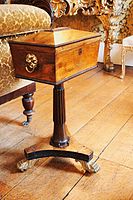Tea caddy
This articleneeds additional citations forverification.(June 2010) |

Atea caddyis a box, jar, canister, or other receptacle used to storetea.When first introduced to Europe from Asia, tea was extremely expensive, and kept under lock and key. The containers used were often expensive and decorative, to fit in with the rest of a drawing-room or other reception room. Hot water was carried up from the kitchen, and the tea made by the mistress of the house, or under her supervision.
The word is believed to be derived fromcatty,the Chinese pound, equal to about a pound and a thirdavoirdupois.The earliest examples that came to Europe were of Chineseporcelain,and similar in shape to theginger-jar.They had Chinese-style lids or stoppers, and were most frequently blue and white.[1]Until about 1800, they were called tea canisters.[2]

At first, English manufacturers imitated the Chinese, but quickly devised forms and ornaments of their own, and mostceramicfactories in the country competed for the supply of the new fashion. Earlier tea caddies were made of eitherporcelainorfaience.Later, designs had more variety in materials and decorations. Wood,pewter,tortoiseshell,brass, copper and silver were employed, but the material most frequently used was wood, and a number of Georgian box-shaped caddies inmahogany,rosewood,satin-woodand other timbers still survive. These were often mounted in brass and delicately inlaid, with knobs of ivory, ebony or silver. Many examples were made in Holland, principally of the earthenware ofDelft.[1]There were also many English factories producing high quality caddies. Soon the Western designs were also being made inChinese export porcelainandits Japanese equivalent.Thecaddy spoon,typically in silver, was a wide shovel-like spoon for the tea, often with a scalloped bowl.
As the use of the jar waned and the box became more popular, the provision of different receptacles forgreenandblack teawas abandoned, and the wooden tea chest or caddy, with a lid and a lock, was made with two and often three divisions for the actual caddies, the center portion being reserved for sugar. In the late 18th and early 19th century, caddies made from mahogany and rosewood were popular. TheChippendalecompany made caddies in the so-calledLouis Quinzefashion, withclaw-and-ball feetand exquisite finish. The designs of the wooden caddies were rich, theinlaysimple and delicate, the form graceful and unobtrusive. Even when shaped like miniaturesarcophagi,imitating the massivewine-coolersof theEmpire style,with little claw feet and brass rings, they were regarded as pleasant.[1]
The larger varieties were known as tea chests. This term was also applied to cube-shaped wooden crates used for exporting tea overseas; now, it denotessimilar boxeschiefly associated withhouse removals.
As tea grew cheaper, there was less concern with the appearance of caddies, and as a result they fell out of use, as tea was kept in the kitchen.[1]
Gallery
[edit]-
A red stoneware tea caddy fromMeissen
-
An English tea caddy decorated withwood inlay
-
Asilverplated tea caddy and acaddy spoon
-
Ocean Queen old styled tea tin
-
The LFB Fleet Teams Tea Caddies
-
Early to mid-19th century rosewood and brass inlaid caddy
-
19th-century tea chest with its own stand
See also
[edit]- Chaki
- Tea chest
- Tea culture
- Kaikadobrand of hand-crafted Japanese tea caddies
References
[edit]- ^abcdOne or more of the preceding sentences incorporates text from a publication now in thepublic domain:Chisholm, Hugh,ed. (1911). "Tea-caddy".Encyclopædia Britannica.Vol. 26 (11th ed.). Cambridge University Press. p. 483.
- ^"Tea canister".Victoria and Albert Museum.







